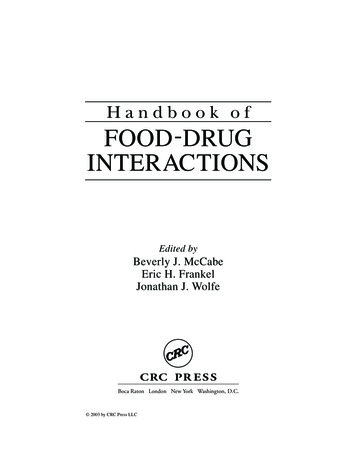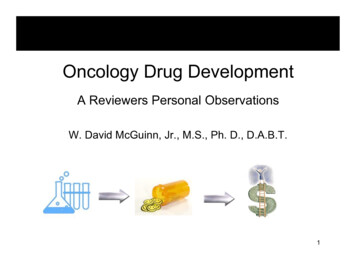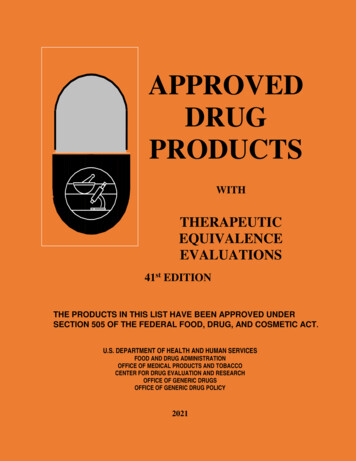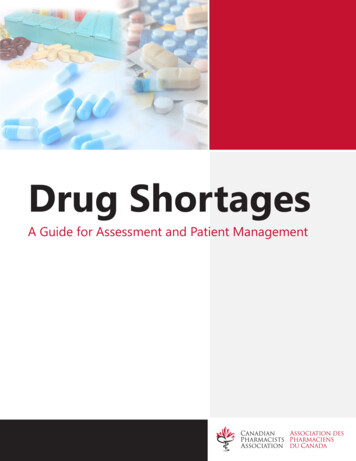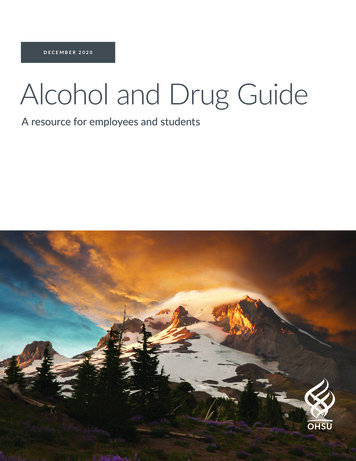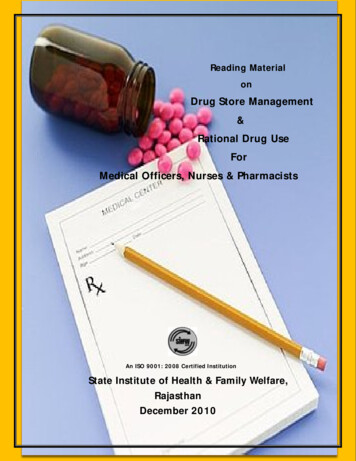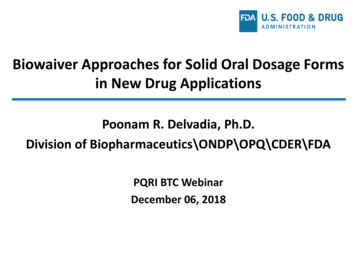
Transcription
Oman Medical Journal (2011) Vol. 26, No. 2: 77-83OmanDOI 10.Medical5001/omj.2011.21Journal (2011) Vol. 26, No. 2: 1-3Review ArticleFood-Drug InteractionsRabia Bushra, Nousheen Aslam, Arshad Yar KhanReceived: 17 Oct 2010 / Accepted: 09 Dec 2010 OMSB, 2011AbstractThe effect of drug on a person may be different than expectedbecause that drug interacts with another drug the person is taking(drug-drug interaction), food, beverages, dietary supplementsthe person is consuming (drug-nutrient/food interaction) oranother disease the person has (drug-disease interaction). A druginteraction is a situation in which a substance affects the activity ofa drug, i.e. the effects are increased or decreased, or they produce anew effect that neither produces on its own. These interactions mayoccur out of accidental misuse or due to lack of knowledge aboutthe active ingredients involved in the relevant substances. Regardingfood-drug interactions physicians and pharmacists recognizethat some foods and drugs, when taken simultaneously, can alterthe body's ability to utilize a particular food or drug, or causeserious side effects. Clinically significant drug interactions, whichpose potential harm to the patient, may result from changes inpharmaceutical, pharmacokinetic, or pharmacodynamic properties.Some may be taken advantage of, to the benefit of patients, butmore commonly drug interactions result in adverse drug events.Therefore it is advisable for patients to follow the physician anddoctors instructions to obtain maximum benefits with least fooddrug interactions. The literature survey was conducted by extractingdata from different review and original articles on general orspecific drug interactions with food. This review gives informationabout various interactions between different foods and drugs andwill help physicians and pharmacists prescribe drugs cautiouslywith only suitable food supplement to get maximum benefit for thepatient.Keywords: Food-drug interaction; Cytochrome P450; Drug;Chelation.IntroductionMedicines can treat and cure many health problems.However, they must be taken properly to ensure that they are safeRabia BushraNousheen AslamCollege of PharmacyZiauddin college of Pharmacy, Ziauddin University, Karachi, Pakistan.E-mail: rabia pharmacist@hotmail.comArshad Yar KhanDept. of ChemistryUniversity of Karachi, Pakistan.and effective. Medications should be extremely specific in theireffects, have the same predictable effect for all patients, never beaffected by concomitant food or other medications, exhibit linearpotency, be totally non-toxic in any dosage and require only a singledose to affect a permanent cure. However, this ideal drug is still tobe discovered.1Many medicines have powerful ingredients that interact withthe human body in different ways. Diet and lifestyle can sometimeshave a significant impact on drugs. A drug interaction is a situationin which a substance affects the activity of a drug, i.e. the effects areincreased or decreased, or they produce a new effect that neitherproduces on its own. Typically, interactions between drugs cometo mind (drug-drug interaction). However, interactions may alsoexist between drugs and foods (drug-food interactions), as well asdrugs and herbs (drug-herb interactions).These may occur out of accidental misuse or due to lack ofknowledge about the active ingredients involved in the relevantsubstances. Interactions between food and drugs may inadvertentlyreduce or increase the drug effect. Some commonly used herbs,fruits as well as alcohol may cause failure of the therapy up a pointof to serious alterations of the patient’s health. The majority ofclinically relevant food-drug interactions are caused by foodinduced changes in the bioavailability of the drug.Major side-effects of some diet (food) on drugs includealteration in absorption by fatty, high protein and fiber diets.2Bioavailability is an important pharmacokinetic parameter whichis correlated with the clinical effect of most drugs. However, inorder to evaluate the clinical relevance of a food-drug interactionthe impact of food intake on the clinical effect of the drug has tobe quantified as well.The most important interactions are those associated with ahigh risk of treatment failure arising from a significantly reducedbioavailability in the fed state. Such interactions are frequentlycaused by chelation with components in food. In addition, thephysiological response to food intake, in particular, gastric acidsecretion, may reduce or increase the bioavailability of certaindrugs.3,4Drug interactions can alter the pharmacokinetics and/orpharmacodynamics of a drug. The pharmacodynamic interactionmay be additive, synergistic, or antagonistic effects of a drug.Drug interactions (DIs) represent an important and widely underrecognized source of medication errors.5 The gastrointestinalabsorption of drugs may be affected by the concurrent use of otherOman Medical Specialty Board
Oman Medical Journal (2011) Vol. 26, No. 2: 77-83agents that,1 have a large surface area upon which the drug can beabsorbed,2 bind or chelate,3 alter gastric pH,4 alter gastrointestinalmotility, or affect transport proteins such as P-glycoprotein. Areduction only in absorption rate of a drug is seldom clinicallyimportant, whereas a reduction in the extent of absorption will beclinically important if it results in sub therapeutic serum levels.5Factors such as nonspecific binding, atypical kinetics, pooreffector solubility, and varying ratios of accessory proteins mayalter the kinetic behavior of an enzyme and subsequently confoundthe extrapolation of in vitro data to the human situation.6Coenzyme Q-10 (CoQ10) is very widely consumed by humans asa food supplement because of its recognition by the public as animportant nutrient in supporting human health. It interferes withintestinal efflux transporter P-glycoprotein (P-gp) and as resultfood-drug interactions arise.7The interaction of natural products and drugs is a commonhidden problem encountered in clinical practice. The interactionsbetween natural products and drugs are based on the samepharmacokinetic and pharmacodynamic principles as drug-druginteractions. Several fruits and berries have recently been shown tocontain agents that affect drug-metabolizing enzymes.8 Grapefruitis the most well-known example, but also sevillian orange, pomeloand star fruit contain agents that inhibit cytochrome P4503A4 (CYP3A4), which is the most important enzyme in drugmetabolism.9The study of drug-drug, food-drug, and herb-druginteractions and of genetic factors affecting pharmacokinetics andpharmacodynamics is expected to improve drug safety and willenable individualized drug therapy. Drugs can show their efficacyonly if administered in appropriate quantity with appropriatecombination of drugs and foods and at appropriate time.In contrast to the easy access to information on drug-druginteractions, the information about food-drug interaction isnot always available conveniently. It is a difficult and complexproblem to accurately determine the effects of food and nutrientson a particular drug. This article aims to help the healthcareprofessionals specially physicians and pharmacists and patientsto become more knowledgeable about drug and food interactions.Electronic search of literatures was conducted over a periodof two months and all original research and review articles wereincluded in this study. No literature was older than 20 years.The drugs were selected and reviewed on the basis of theirgeneral utilization pattern and realizing the need for reportingtheir interaction with different dietary supplements for bettertherapeutic use of these drugs within the recommended doseregimen.Fruit JuicesAmong all fruit juices, grape fruit juice (GFJ) possesses highinteraction with almost all types of drugs. The juice modifies thebody’s way of metabolizing the medication, affecting the liver’sability to work the drug through a person’s system. TaniguchiOman Medical Specialty Boardin 2007 reported a case of purpura associated with concomitantingestion of cilostazol, aspirin and grapefruit juice in 79 yearsold man. His purpura disappeared upon cessation of grapefruitjuice, although his medication was not altered. The most probablecause of his purpura is an increase in the blood level of cilostazolbecause of the inhibition of cilostazol metabolism by componentsof grapefruit juice; Taniguch.9Numerous reports have documented drug interactions with GFJthat occur via inhibition of CYP3A enzymes.10 Furanocoumarinspresent in GFJ inhibit the intestinal CYP 3A4 and have beenshown to increase the oral bioavailability of medications that areCYP 3A4 substrates like Felodipine, midazolam, cyclosporine andraise their concentrations above toxic levels.11GFJ is generally contraindicated to patients takingpsychotropics and it is advised to inform patients about describedinteraction.12 The in vitro data suggest that compounds present ingrapefruit juice are able to inhibit the P-gp activity modifying thedisposition of drugs that are P-gp substrates such as talinolol.13The overall exposure of some drugs can be increased by more thanfivefold when taken with GFJ and increase the risk of adverseeffects.14With new anticonvulsants, serum iron and sodium need tobe monitored. Additionally, users are advised to avoid drinkinggrape fruit juice within 1-2 hr(s) of taking these anticonvulsants.15Furanocoumarines and active bioflavonoids present in GFJ are alsoinhibitors of OATP and when ingested concomitantly, can reducethe oral bioavailability of the OATP substrate, fexofenadine.16Overall, a series of flavonoids present in GFJ are identified asesterase inhibitors, of which kaempferol and naringenin areshown to mediate pharmacokinetic drug interaction with mostof the calcium channel antagonist and the statin groups of drugssuch as enalapril and lovastatin due to their capability of esteraseinhibition.17Cholesterol-lowering agent lovastatin should be taken withfood to enhance gastrointestinal absorption and bioavailability.The absorption of rosuvastatin, another anti-hyper lipidemicagent, was significantly decreased in the fed state compared withthe fasting state, which suggests that rosuvastatin should beadministered on an empty stomach.18Simvastatin, Ezetimibe, pravastatin and fluvastatin may betaken without regards to food. However, high fiber diets maylower the efficacy of these drugs.19 Concomitant administrationof statins with food may alter statin pharmacokinetics orpharmacodynamics, increasing the risk of adverse reactions suchas myopathy or rhabdomyolysis or reducing their pharmacologicalaction. Consumption of pectin or oat bran together with Lovastatinreduces absorption of the drug, while alcohol intake does notappear to affect the efficacy and safety of Fluvastatin treatment.20WarfarinWarfarin is commonly used to treat or prevent thromboembolicevents.21 Patients taking warfarin are at particular risk of
Oman Medical Journal (2011) Vol. 26, No. 2: 77-83interactions with dietary supplements, yet approximately 30%use herbal or natural product supplements on a regular basis.22There is a possible interaction between warfarin and a highprotein diet. The potential for increased dietary protein intaketo raise serum albumin levels and/or cytochrome P450 activityhas been postulated as mechanisms for the resulting decrease ininternational normalized ratio (INRs).23Some vegetables (broccoli, Brussels sprouts, kale, parsley,spinach, and others) are high in vitamin K. Eating large quantitiesor making sudden changes in the amounts eaten of these vegetables,interferes with the effectiveness and safety of warfarin therapy.24Eating charbroiled food may decrease warfarin activity,while eating cooked onions may increase warfarin activity.25Soy foods have been reported both to increase and to decreasewarfarin activity.25 The significance of these last three interactionsremains unclear. The combination of warfarin administrationand cranberry juice ingestion appeared to be associated with anelevated INR without bleeding in elderly patient.A number of studies have been documented on the interactionof warfarin and cranberry juice.26-30 Cranberry juice is a flavonoid,which has been shown to induce, inhibit, or act as a substrate forthe biosynthesis of several cytochrome P-450 (CYP) isoenzymes.Specifically, cranberry juice may inhibit the activity of CYP2C9,the primary isoenzyme involved in the metabolism of S-warfarin.It was suggested that cranberry juice increased the InternationalNormalized Ratio (INR) of patients taking warfarin, butneither clearly identified cranberry juice as the sole cause ofINR elevation.31 If warfarin sodium is ingested with leafy greenvegetables, the hypoprothrombinemic effect of warfarin may bedecreased and thromboembolic complications may develop.32interaction.36Antihypertensive DrugsPatients placed on anti hypertensive drugs will benefit fromconcomitant moderate sodium restricted diets.23 Propranolol serumlevels may be increased if taken with rich protein food. A changein diet from high carbohydrates/low protein to low carbohydrate/high protein may result in increased oral clearance. Smokingmay decrease its plasma levels of by increasing its metabolism.37The intestinal absorption of celiprolol (beta-blocker) is inhibitedwhen it is taken with orange juice. Hesperidin, present in orangejuice, is responsible for the decreased absorption of celiprolol.38The absorption of ACEs inhibitors is increased when taken onan empty stomach.39 While GFJ increases the bioavailability offelodipine (Ca2 channel blocker).39Licorice extract, a common ingredient of dietary supplementcontains glycyrrhizin and glycyrrhetinic acid. It is a potent inhibitorof 11- bet- hydroxyl steroid dehydrogenase, it increases excess ofcortisol to mineralocorticoid receptors causing sodium retentionand potassium depletion, so it may interfere with various medicinesincluding antihypertensive and antiarrhythmic agents.40,41 A highintake of liquorice can cause hypermineralocorticoidism withsodium retention and potassium loss, oedema, increased bloodpressure and depression of the renin-angiotensin-aldosteronesystem.42 Studies showed that a daily consumption of glycyrrhizicacid of 95 mg or more caused an increase in blood pressure. Apractical guideline for an acceptable daily intake of glycyrrhizicacid seems to be 9.5 mg a day. This means no more than 10-30gliquorice and no more than half a cup of liquorice tea a day.43AntibioticsMonoamnine OxidasesAntidepressant activity of monoamine oxidase inhibitors (MAOIs)was initially noted in the 1950s. Although older monoamineoxidase inhibitors (MAOIs) are effective in the treatment ofdepressive disorders, they are under-utilized in clinical practice dueto main concerns about interaction with tyramine-containing food(matured cheese, red vine, ripped bananas, yogurt, shrimp pasteand salami) or so called cheese reaction, since they are capable ofproducing hypertensive crisis in patients taking MAOIs.33The first-generation MAOIs such as phenelzine andisocarboxazid were largely nonselective inhibitors of bothsubtypes of MAO, MAO (A) and MAO (B). These medicationscarried with them dietary restrictions.34 Tyramine is an indirectlyacting sympathomimetic agent, is degraded by MAO but inthe presence of MAOIs, it escapes degradation and reaches thesystemic circulation where it is taken up by the adrenergic neuron,leading to a hypertensive crisis.35 However, MAOIs have been wellestablished as an effective intervention for people with treatmentresistant depression, and transdermal formulations may providea valuable therapeutic option and eliminate the drug-foodAntibiotics are widely prescribed in medical practice. Many ofthem induce or are subject to interactions that may diminishtheir anti-infectious efficiency or elicit toxic effects. Food intakecan influence the effectiveness of an antibiotic.44 Avoid coadministration of antibiotics with milk products which are richsources of divalent ions, such as calcium and magnesium thatcomplex with some antibiotics and prevent their absorption. Theintake of dairy products, however, needs to be monitored andencouraged with appropriate consideration of specific antibioticsinvolved.45A number of studies give evidence that fluoroquinolonesforming slightly soluble complex with metal ions of food showreduced bioavailability.46 Casein and calcium present in milkdecrease the absorption of ciprofloxacin.47 The effect of interactionof five fruit juices on the dissolution and absorption profiles ofciprofloxacin tablets were determined. It was found that theabsorption of ciprofloxacin (500 mg) tablets can be reduced byconcomitant ingestion of the GFJ.48 Therefore, to avoid drugtherapeutic failures and subsequent bacterial resistance as a resultof sub-therapeutic level of the drug in the systemic circulation,ingestion of the juice with ciprofloxacin should be discouraged.48Oman Medical Specialty Board
Oman Medical Journal (2011) Vol. 26, No. 2: 77-83Azithromycin absorption is decreased when taken with food,resulting in a 43% reduction in bioavailability.39 Tetracyclineshould be taken one hour before or two hours after meals, andnot taken with milk because it binds calcium and iron, forminginsoluble chelates, and influencing its bioavailability.39,49,50 Theeffect of milk added to coffee or black tea on the bioavailability oftetracycline was evaluated in healthy individuals. Results showedthat even a little quantity of milk containing extremely smallamounts of calcium severely impair the absorption of the drug, sothat the presence of this metal ion should be carefully controlled inorder to avoid decreasing the available tetracycline.51Food-drug interactions may reduce the bioavailability of drugstaken after meals (negative food effects). However, enteric-coatedtablets that start to disintegrate when they reach the middle-tolower region of the small intestine could reduce negative foodeffects. Results indicated that food-drug interactions were avoidedby separating the main absorption site of drugs from that of foodcomponents.52Analgesics and AntipyreticsAnalgesics and antipyretics are used to treat mild to moderatepain and fever. For rapid relief, acetaminophen should be takenin an empty stomach because food may slow the body absorptionof acetaminophen. Co-administration of acetaminophen withpectin delays its absorption and onset.53 NSAIDs like ibuprofen,naproxen, ketoprofen and others can cause stomach irritation andthus they should be taken with food or milk. Avoid or limit the useof alcohol because chronic alcohol use can increase the risk of liverdamage or stomach bleeding.39 The absorption of ibuprofen andoxycodone when given in the combination tablet was affected bythe concomitant ingestion of food.54The Cmax and AUC0-alpha of ibuprofen were significantly increasedafter single and multiple doses of Coca-Cola, thereby indicatingincreased extent of absorption of ibuprofen. The daily dosage andfrequency of ibuprofen must be reduced when administered withCoca-Cola.55 Food intake did not appear to affect the extent ofabsorption (ie, total exposure) of oral Diclofenac potassium softgelatin capsule at doses.56BronchiodilatorsBronchodilators like theophylline, albuterol, and epinephrinepossess different effects with food. The effect of food ontheophylline medications can vary widely. High-fat meals mayincrease the amount of theophylline in the body, while highcarbohydrate meals may decrease it. Avoid alcohol if takingtheophylline medications because it can increase the risk ofside effects such as nausea, vomiting, headache and irritability.Avoid eating or drinking large amounts of foods and beveragesthat contain caffeine (e.g., chocolate, colas, coffee, and tea) sincetheophylline is a xanthine derivative and these substances alsocontain xanthine. Hence consuming large amounts of thesesubstances while taking theophylline, increases the risk of drugOman Medical Specialty Boardtoxicity.39 Additionally, both oral bronchodilators and caffeinestimulate the central nervous system.57 Patients may be advisednot to consume GFJ when taking theophylline, since it increasesthe bioavailability,58 and monitoring of plasma theophylline levelsin patients consuming GFJ might be helpful in better managementof patient care.59AntihistaminesFexofenadine, loratadine, rupatadine, cimetidine cetirizine, areall antihistamines.60 It is best to take prescription antihistamineson an empty stomach to increase their effectiveness. Rupatadineis commonly used for the management of diseases with allergicinflammatory conditions. A study indicates that concomitantintake of food with a single 20 mg oral dose of rupatadine exhibitsa significant increase in rupatadine bioavailability.61 Cimetidineis given with food to assist the maintenance of a therapeuticblood concentration. A fraction of cimetidine is absorbed in thepresence of food, allowing the remaining drug to be dissolvedonce the gut is cleared. Thus, therapeutic levels are maintainedthroughout the dosing interval.62,63 A study was conducted on alatest molecule esomeprazole (acid-reducer), and it was observethat its bioavailability was reduced when taken within 15 minbefore eating a high-fat meal vs. that while fasting. 64Antitubercular DrugsAnti-tubercular drugs like isoniazid have been associated withtyramine and histamine interactions.65 Inhibition of monoamineoxidase and histaminase by isoniazid can cause significant drugfood interactions. Food greatly decreases isoniazid bioavailability.66Oleanolic acid, a triterpenoid exists widely in food, medicinalherbs and other plants, has antimycobacterial activity against theMycobacterium tuberculosis, when administered with isoniazid, itexerts synergistic effect.67High fat meals decrease the serum concentration of cycloserine,a bacteriostatic anti-tubercular drug and results in incompleteeradication of bacteria.68AntidiabeticsGlimepiride is an antidiabetic and a new generation sulfonylureaderivative should be administered with breakfast or the firstmain meal of the day. It has absolute bioavailability and theabsence of food interaction guarantee highly reproduciblepharmacokinetics.69 Immediate release glipizide should be taken30 minutes before meals. However, extended release tablets shouldbe taken with breakfast.70 The maximum effectiveness of acarbose,an alpha-glucosidase inhibitor is attained when the drug is takenimmediately at the start of each meal (not half an hour before orafter), because it delays the carbohydrate absorption by inhibitingthe enzyme alpha-glucosidase.35
Oman Medical Journal (2011) Vol. 26, No. 2: 77-83ThyroxineRecent evidence pointed out the role of gastric acid secretionon the subsequent intestinal absorption of thyroxine in relationwith the timing of food ingestion as well as with pH impairmentassociated to frequent gastric disorders like Helicobacter pyloriinfection and gastric atrophy.71 Levothyroxine is a derivative ofthyroxine. Grapefruit juice may slightly delay the absorptionof levothyroxine, but it seems to have only a minor effect on itsbioavailability. Accordingly, the clinical relevance of the grapefruitjuice-levothyroxine interaction is likely to be small.72Drug interactions may be theoretical or clinically relevant. Asummary table is given to highlight some significant food-druginteractions. (Table 1)Some may be taken advantage of, to the benefit of patients, butmore commonly drug interactions result in unnecessary adverseevents. Fortunately, undesirable drug interactions can be prevented.Becoming more familiar with potential drug interactions can helpclinicians predict and explain a patient’s response to medications.73Significant food effects complicate development of new drugs,especially when clinical plans require control and/or monitoringof food intake in relation to dosing. The prediction of whether adrug or drug product will show human food effect is challenging.74Table 1: Summary of some significant Food-Drug InteractionsDrugsFoodDrug-Food InteractionWARFARINHigh-protein dietraise serum albumin levels, decrease in internationalnormalized ratio (INR)MONOAMNINE OXIDASESVegetables containing vitamin kCharbroiledCooked onionsCranberry juiceLeafy green vegetablesCharbroiledTyramine-containing food1interferes with the effectiveness and safety of warfarin therapy.decrease warfarin activityincrease warfarin activityelevated INR without bleeding in elderly patientthromboembolic complications may developdecrease warfarin activityhypertensive crisisPROPRANOLOLRich protein foodserum level may be increasedCELIPROLOLOrange juicethe intestinal absorption is inhibitedACES INHIBITORSEmpty stomachabsorption is increasedCA2 CHANNELGrape fruit juiceincreases the bioavailabilityANTIBIOTICSwith milk products2that complex with some antibiotics and prevent theirabsorption. reduced bioavailabilityACETAMINOPHENPectindelays its absorption and onsetNSAIDSAlcoholcan increase risk of liver damage or stomach bleedingBeveragesthe c max and auc0-alpha significantly increased3THEOPHYLINEHigh-fat meal and grape fruit juice increase bioavailabilityCaffeineincreases the risk of drug toxicityESOMEPRAZOLEHigh-fat mealbioavailability was reducedCIMETIDINE, RUPATADINE with food(any type)increase bioavailabilityISONIAZIDEPlantsmedicinal herbsoleanolic acid exerts synergistic effectCYCLOSERINEHigh fat mealsdecrease the serum concentrationESOMEPRAZOLEHigh-fat mealbioavailability was reducedCIMETIDINE, RUPATADINE with food(any type)increase bioavailabilityISONIAZIDEPlantsmedicinal herbsoleanolic acid exerts synergistic effectCYCLOSERINEHigh fat mealsdecrease the serum concentrationGLIMEPIRIDEwith breakfastabsolute bioavailabilityACARBOSE,at start of each mealmaximum effectiveness4reduce bioavailabilityMERCAPTOPURINECow's milkTAMOXIFENSesame seedsnegatively interferes with tamoxifen in inducing regression ofestablished mcf-7 tumor size but beneficially interacts withtamoxifen on bone in ovariectomized athymic miceLEVOTHYROXINEGrapefruit juicedelay the absorption5GLIMEPIRIDEwith breakfastabsolute bioavailabilityOman Medical Specialty Board
Oman Medical Journal (2011) Vol. 26, No. 2: 77-83Antitumor DrugsMercaptopurine is a purine analog used for acute lymphoblasticleukemia and chronic myelogenous leukemias. Since it isinactivated by xanthine oxidase (XO), concurrent intake ofsubstances containing XO may potentially reduce bioavailabilityof mercaptopurine. Cow’s milk is known to contain a high level ofXO. This interaction may be clinically significant. Therefore mostpatients should try to separate the timing of taking mercaptopurineand drinking milk.75Tamoxifen is a successful anti-tumor agent. If taken withsesame seeds, it negatively interferes with tamoxifen in inducingregression of established MCF-7 tumor size but beneficiallyinteracts with tamoxifen on bone in ovariectomized athymicmice.76 Xue et al. had compared the influence of dietary elementson cancer progression, chemotherapy efficacy, and toxicity,particularly severe, late onset diarrhea related to irinotecan (CPT11) treatment. They suggest that glutamine and n-3 fatty acidsmight be potentially useful adjuncts with CPT-11 treatment.77ConclusionA large number of drugs are introduced every year. Food-druginteractions can produce negative effects in safety and efficacyof drug therapy, as well in the nutritional status of the patient.Generally speaking, drug interactions are to be avoided, dueto the possibility of poor or unexpected outcomes. Like food,drugs taken by mouth must be absorbed through the lining ofthe stomach or the small intestine. Consequently, the presenceof food in the digestive tract may reduce absorption of a drug.Often, such interactions can be avoided by taking the drug 1 hourbefore or 2 hours after eating. Like drugs, foods are not tested ascomprehensively so they may interact with prescription or overthe-counter drugs. The authors would suggest patients to telltheir doctors and pharmacists about their food intake and dietarysupplements so that interactions can be avoided.AcknowledgementsThe author reported no conflict of interest and no funding wasreceived on this 23.24.25.26.References1.2.3.4.5.6.27.Frankel EH. (2003). Basic Concepts. In: Hand book of food-drug Interactions,McCabe BJ, Frankel EH., Wolfe JJ (Eds.) pp. 2, CRC Press, Boca Raton, 2003.Ayo JA, Agu H, Madaki I. Food and drug interactions: its side effects. NutrFood Sci 2005;35(4):243-252Schmidt LE, Dalhoff K. Food-drug interactions. Drugs 2002;62(10):14811502.Nekvindová J, Anzenbacher P. Interactions of food and dietary supplementswith drug metabolising cytochrome P450 enzymes. Ceska Slov Farm 2007Jul;56(4):165-173.Hansten PD. (2004) Appendix II: important interactions and theirmechanisms, In: Katzung BG. (2004). editor, 09th edn, (2004) Basic andclinical Pharmacology, McGraw hill, Boston pp 1110.Itagaki, S., Ochiai, A., Kobayashi, M., Sugawara, M., Hirano, T., Iseki,Oman Medical Specialty Board28.29.30.31.32.K.(2008). Interaction of Coenzyme Q10 with the Intestinal Drug TransporterP-Glycoprotein. J Agric Food Chem. 27; 56(16):6923-7.Joshi R, Medhi B. Natural product and drugs interactions, its clinical implicationin drug therapy management. Saudi Med J 2008 Mar;29(3):333-339.Molden E, Spigset O. Fruit and berries–interactions with drugs. Tidsskr NorLaegeforen 2007 Dec;127(24):3218-3220.Kirby BJ, Unadkat JD. Grapefruit juice, a glass full of drug interactions? ClinPharmacol Ther 2007 May;81(5):631-633.Pawełczyk T, Kłoszewska I. Grapefruit juice interactions with psychotropicdrugs: advantages and potential risk. Przegl Lek 2008;65(2):92-95.de Castro WV, Mertens-Talcott S, Derendorf H, Butterweck V. Grapefruit juicedrug interactions: Grapefruit juice and its components inhibit P-glycoprotein(ABCB1) mediated transport of talinolol in Caco-2 cells. J Pharm Sci 2007Oct;96(10
The study of drug-drug, food-drug, and herb-drug interactions and of genetic factors affecting pharmacokinetics and pharmacodynamics is expected to improve drug safety and will enable individualized drug therapy. Drugs can show their efficacy only if administered in appropriate quantity with appropriate

